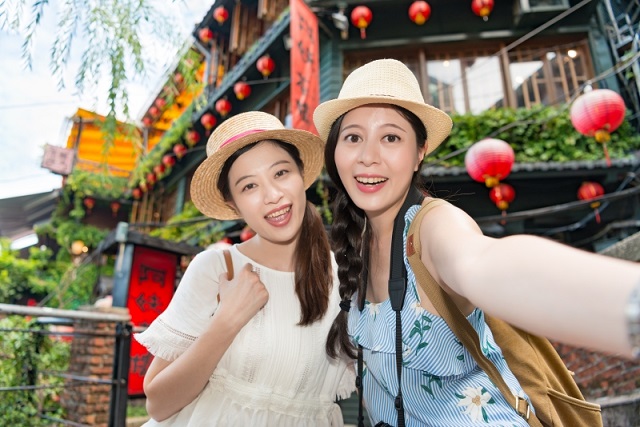Lin Hsiu-tzu
Don’t Tell the Japanese to Visit Jiufen Anymore!

Source:Shutterstock
Repeat visitors from Japan are interested in delving deeper into Taiwan’s culture and geography.
Views
Don’t Tell the Japanese to Visit Jiufen Anymore!
By Hsiu-tzu LinOpinion@CommonWealth
Editors' Note: This article is translated from an op-ed from Opinion@CommonWealth
Mr. Sakai, a Japanese teacher, once made a telling remark: “There’s no way I’d recommend that Japanese people visit Jiufen, because Jiufen doesn’t have anything to offer but stairs.”
Jiufen is actually not that bad, but the image Japanese travelers have about Taiwan is definitely changing. For Japanese tourists who visit Taiwan for the first time, Jiufen, with its many stairways, is probably reminiscent of Japan’s “sakamichi” sloping roads. However, in recent years, the number of Japanese visitors who come to Taiwan for the umpteenth time has increased dramatically thanks to the popularity of cheap overnight trips.
Last year, Taiwan saw nearly two million tourists arrive from Japan, including a growing number who come for repeat visits. Japanese women in particular love to visit Taiwan on short trips over the weekend. Japanese media once reported that for the average Japanese, Okinawa feels more remote and foreign than does Taiwan.
A key reason for Japanese travelers to revisit Taiwan again and again is that the island offers scenery reminiscent of Japan, and because it makes them feel as safe as they do at home despite having left the country.
Cheap Flights and Street Food
In recent years, Taiwan has become a kind of extension of Japan. Popular restaurants provide menus in Japanese, the ubiquitous convenience stores stock numerous Japanese food items and snacks, and many Japanese chain restaurants have opened outlets in Taiwan. And then there are the Japanese-style buildings lining the streets as well as the friendly Taiwanese people who make the Japanese feel very much at ease.
A short while ago, one Taiwanese lawmaker wondered how it could be that Japanese tourists can visit Taiwan at miraculously low prices, paying only around 20,000 yen (about NT$5,300) for a trip of three days and two nights. The lawmaker voiced suspicion that the Taiwanese government secretly subsidizes the trips out of its own pockets.
In fact, it is common knowledge in Japan that short trips to Taiwan lasting three days and two nights cost around 20,000 yen, not counting airfare.
An Internet search of Japanese travel blogs on “how to have fun in Taiwan” or “Taiwan on a shoestring budget" yields a long list of blogs whose young Taiwan-loving authors have visited Taiwan dozens of times. They advise Japanese youngsters against booking package tours, telling them to catch cheap flights to Taiwan instead. Rather than limiting themselves to the [well-traveled] northern part of the island, these travel writers venture further to the South and the East. Travelogues about Tainan, Kaohsiung and Hualien can be readily found online.
More than Dumplings and Mango Shaved Ice
It goes without saying that these bloggers update their sites with the latest Taiwan travel information. Even the [traditional] Japanese media reflect the changing attitudes about what is considered good fun and good food when traveling in Taiwan.
The generous donations from Taiwan after a massive earthquake hit Japan on March 11 six years ago left a deep impression on the Japanese. At the time, the Taiwan tours recommended by the Japanese media mainly covered Jiufen in the North and Taipei’s Dihua Street. Typically featured food did not go beyond Din Tai Fung steamed soup dumplings (xiao long bao) and mango shaved ice from Yongkang Street. And then there was Taiwanese tea that could always be brought back as souvenir.
But this year, Guohua Street in Tainan has already made it to the cover of the Japanese lifestyle magazine Brutus. The story inside features delicious treats other than soup dumplings and mango shaved ice. Among the new “must eats” are popular snacks and drinks such as hand-shaken tea beverages, boiled dumplings, spicy Mapo tofu, Hong Rui Zhen sandwiches, pork belly buns, squid with rice noodles, sticky Taiwanese “ba-wan” meatballs and so on.
 Image: BRUTUS
Image: BRUTUS
The frequent Taiwan travelers among the Japanese bloggers no longer recommend upscale restaurants that exclusively cater to foreign tourist groups. Instead, they enthusiastically share their own good times in Taiwan.
Masayoshi Okumura, also known as “Okkun” online, who has visited Taiwan more than a dozen times, recommends 7-Eleven Oden (link in Japanese) with the addition of Little Prince snack noodles. Moreover, the blogger, who has also visited Taipei many times, recommends Fu Hang soy milk and the steamed soup dumplings the locals like to eat at Yong He Soy Milk King breakfast stores. These visitors tour Taiwan like locals, taking the subway and riding U-Bike rental bikes, enjoying a more Taiwanese experience.
Like Taiwanese bloggers who feature must-buys and must-eats in Tokyo and Osaka, the Japanese bloggers write about their top souvenir picks from Taiwan (link in Japanese). These include Taiwanese mango beer, salted and air-dried mullet roe, handmade Yuan soaps and Beauty Diary facial masks. Also popular are items most Taiwanese haven’t even heard of such as Charm Villa goldfish-shaped tea bags, red wine, chocolate and everyday items that most Taiwanese would never consider suitable as a souvenir, such as school notebooks and decorative tapes (which most Taiwanese tourists bring back from Japan).
Cute Pets at Mid-Autumn Festival
Many Japanese believe it is most worthwhile visiting Taiwan during the mango season in the summer or to witness local customs during the Mid-Autumn Festival (or Moon Festival). While Tsukimi, the Japanese variant of this festival, is a rather solemn affair where people eat dango rice dumplings to honor the autumn moon, families in Taiwan gather for boisterous barbecue parties.
Another popular pastime during the holiday is making hats from pomelo rinds for kids or pets to wear. The Japanese find such pomelo-helmeted cats and dogs simply adorable. As a result, many Japanese travel guides mention the “cute” sights one might come across when visiting Taiwan during the Mid-Autumn Festival.
 Image: David Hsu/Flickr
Image: David Hsu/Flickr
The Japanese are not just interested in celebrating the Mid-Autumn Festival Taiwan-style; they are also keen to taking advantage of the autumn sales at local department stores. Consequently, most travel guides not only recommend the mango season but also October and November, when travelers can experience the Mid-Autumn Festival as well as autumn sales.
The Japanese are becoming increasingly sophisticated regarding traveling in Taiwan, moving on from just having an affinity for Taiwan to actually knowing the island, which should be a good thing for all.
Translated from the Chinese article by Susanne Ganz

Opinion@CommonWealth website is a sub-channel of CommonWealth Magazine. Founded in January 2013 with its main focus on social, humanity and policy issues and opinions, Opinion@CommonWealth is dedicated to building a democratic, diverse platform where multi opinions can be presented.
Currently, there are approximately 100 columnists and writers co-contributing on Opinion@CommonWealth to contemplating and exploring Taiwan's future with the Taiwanese society.
Additional Reading
♦ Round-Island Touring: Circle Taiwan With a Bike – A New Trend for Japanese
♦ Why Hong Kong Is Smitten with Taiwan
♦ A Must Do Activity When Visiting Kaohsiung:‘One-Day Farmer’ Tour Has Hit Abroad







